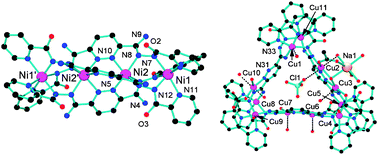Unexpected Ni(ii) and Cu(ii) polynuclear assemblies—a balance between ligand and metal ion coordination preferences†
Abstract
Polytopic ligand design involves matching the coordination pocket composition with the metal ion coordination ‘algorithm’, but despite targeting [4 × 4] grids as the final outcome, metal ion preferences and ligand control can lead to widely varying complexes in the


 Please wait while we load your content...
Please wait while we load your content...